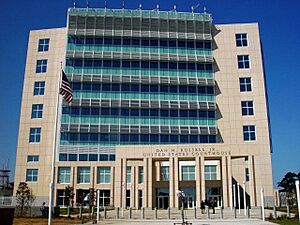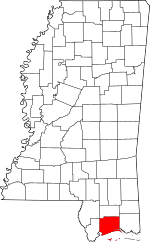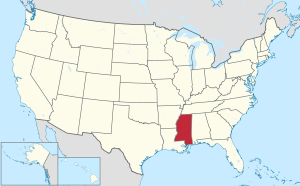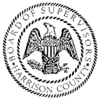Harrison County, Mississippi facts for kids
Quick facts for kids
Harrison County
|
|||
|---|---|---|---|

Dan M. Russell Jr. United States Courthouse in Gulfport, Harrison County
|
|||
|
|||

Location within the U.S. state of Mississippi
|
|||
 Mississippi's location within the U.S. |
|||
| Country | |||
| State | |||
| Founded | 1841 | ||
| Named for | William Henry Harrison | ||
| Seat | Biloxi and Gulfport | ||
| Largest city | Gulfport | ||
| Area | |||
| • Total | 976 sq mi (2,530 km2) | ||
| • Land | 574 sq mi (1,490 km2) | ||
| • Water | 402 sq mi (1,040 km2) 41% | ||
| Population
(2020)
|
|||
| • Total | 208,621 | ||
| • Estimate
(2023)
|
210,612 |
||
| • Density | 213.75/sq mi (82.53/km2) | ||
| Time zone | UTC−6 (Central) | ||
| • Summer (DST) | UTC−5 (CDT) | ||
| Congressional district | 4th | ||
Harrison County is a place in the state of Mississippi, USA. It's like a big neighborhood or region. In 2020, about 208,621 people lived here. The main towns where the county government works are Biloxi and Gulfport. The county is named after William Henry Harrison, who was once a U.S. President. Harrison County is part of the larger Gulfport-Biloxi area. This county has faced big storms, like Hurricane Camille in 1969 and Hurricane Katrina in 2005, which caused a lot of damage.
Contents
Geography
Harrison County covers a total area of about 976 square miles. A large part of this, about 402 square miles (or 41%), is covered by water. The Tchoutacabouffa River flows into Biloxi Bay, which is just north of Biloxi city. Gulfport, Mississippi is a very important port for the state. Ships can get to the Gulf of Mexico from there through a special channel. Harrison County is the second-largest county in Mississippi when you look at its total area.
Wildlife
There's a special pond in Harrison County that is home to a very rare type of frog called the dusky gopher frog. This frog is critically endangered, meaning it's at a very high risk of disappearing forever.
Major roads
 Interstate 10
Interstate 10 Interstate 110
Interstate 110 U.S. Highway 49
U.S. Highway 49 U.S. Highway 90
U.S. Highway 90 Mississippi Highway 15
Mississippi Highway 15 Mississippi Highway 53
Mississippi Highway 53 Mississippi Highway 67
Mississippi Highway 67 Mississippi Highway 605
Mississippi Highway 605 Mississippi Highway 43
Mississippi Highway 43
Neighboring counties and parishes
- Stone County (north)
- Jackson County (east)
- Hancock County (west)
- St. Bernard Parish, Louisiana (southwest)
Protected natural areas
- De Soto National Forest (part)
- Gulf Islands National Seashore (part)
Population facts
| Historical population | |||
|---|---|---|---|
| Census | Pop. | %± | |
| 1850 | 4,875 | — | |
| 1860 | 4,819 | −1.1% | |
| 1870 | 5,795 | 20.3% | |
| 1880 | 7,895 | 36.2% | |
| 1890 | 12,481 | 58.1% | |
| 1900 | 21,002 | 68.3% | |
| 1910 | 34,658 | 65.0% | |
| 1920 | 32,855 | −5.2% | |
| 1930 | 44,143 | 34.4% | |
| 1940 | 50,799 | 15.1% | |
| 1950 | 84,073 | 65.5% | |
| 1960 | 119,489 | 42.1% | |
| 1970 | 134,582 | 12.6% | |
| 1980 | 157,665 | 17.2% | |
| 1990 | 165,365 | 4.9% | |
| 2000 | 189,601 | 14.7% | |
| 2010 | 187,105 | −1.3% | |
| 2020 | 208,621 | 11.5% | |
| 2023 (est.) | 210,612 | 12.6% | |
| U.S. Decennial Census 1790-1960 1900-1990 1990-2000 2010-2020 |
|||
2020 population details
| Race | Number | Percent |
|---|---|---|
| White (not Hispanic) | 125,092 | 59.96% |
| Black or African American (not Hispanic) | 51,143 | 24.51% |
| Native American | 786 | 0.38% |
| Asian | 5,913 | 2.83% |
| Pacific Islander | 257 | 0.12% |
| Other/mixed | 11,454 | 5.49% |
| Hispanic or Latino | 13,976 | 6.7% |
In 2020, the 2020 United States census counted 208,621 people living in Harrison County. There were 74,628 households and 50,074 families.
Communities

Cities
- Biloxi (one of the county seats)
- D'Iberville
- Gulfport (one of the county seats)
- Long Beach
- Pass Christian
Census-designated places
These are areas that are like towns but not officially incorporated as cities.
Unincorporated communities
These are smaller communities that are not part of any city or census-designated place.
Education
Here are the different school districts in Harrison County:
- Biloxi Public School District
- Gulfport School District
- Harrison County School District
- Long Beach School District
- Pass Christian Public School District
See also
 In Spanish: Condado de Harrison (Misisipi) para niños
In Spanish: Condado de Harrison (Misisipi) para niños



